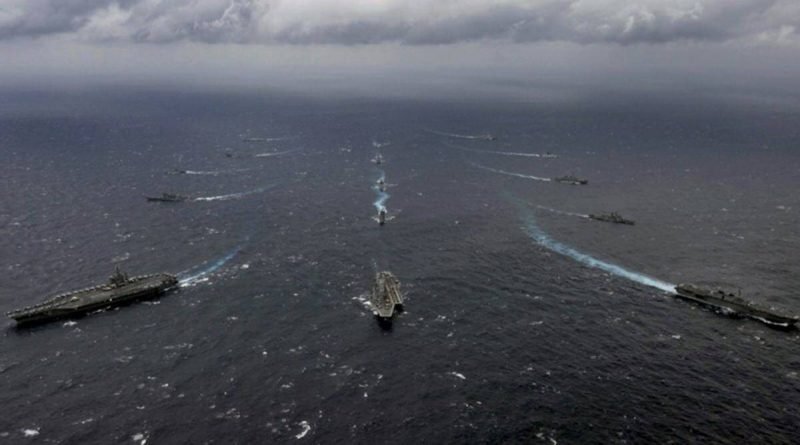Geopolitical challenges in the Bay of Bengal Region

Introduction
The Bay of Bengal appears to be a calm sea at first glance, except for the seasonal cyclones that disrupt life in the littoral. It is nearly a closed sea, with only three countries bordering its northern reaches: Myanmar, Bangladesh, and India. The northern waters of the Bay are also far from the main sea lines of communication in the Indian Ocean that connect the dynamic economies of East Asia with the traditional markets of Europe via the oil-rich Gulf and rapidly growing Africa. The countries bordering the Bay of Bengal are home to a quarter of the world’s population, with approximately 400 million people living in its catchment areas. As a result, the Bay is one of the most densely populated coastlines on the planet. The region has not seen any serious great-power rivalries nor major conflicts in the recent past. This sense of calm in the waters of the Bay of Bengal, however, has begun to erode over the last decade. It is on the verge of becoming a hotbed of geopolitical rivalry among major powers and regional conflict. Robert Kaplan in his famous book named “Monsoon”, argues how the Indian Ocean Region is on its way to becoming the Nexus of World power and conflict in the coming years. As Bay of Bengal is already a Major part of the Indian Ocean Region, the power play that takes place therein will have a significant effect on the shaping of the regional strategic landscape. The Bay of Bengal is becoming increasingly strategic for a number of countries. With ever-increasing energy demands, the protection of Sea Lines of Communications (SLOC) is becoming a priority for Asian countries. Because the Bay of Bengal connects to the Malacca Strait, which connects to the South China Sea (SCS), these routes are critical to the economies of the SCS (China, Japan). On a geostrategic level, the Bay of Bengal connects the South East Asian economy to Middle Eastern oil sources via the South Asian Association for Regional Cooperation (SAARC) and the Association of South East Asian Nations (ASEAN). The Bay’s tremendous economic potential, owing to its untapped natural resources, makes it strategically important for its littoral countries, namely Bangladesh, Myanmar, Malaysia, Thailand, Singapore, Indonesia, Sri Lanka, and India, as well as global powers such as the United States and China. This explains the increasing interest and involvement of non-littoral players in the Bay of Bengal Region.
In terms of foreign policy strategy, China is clearly pursuing a “Look South” policy, as evidenced by its significant infrastructure investments in the countries surrounding the Bay. With its Asia “Rebalancing” strategy, India is opting for a “Look East” policy to strengthen connectivity to Southeast Asia and the United States, shifting its focus away from the Middle East and toward this dynamic region.

Reasons for the Rising importance of the Bay of Bengal Region
The growing importance of the Bay of Bengal is linked to the rapid economic growth of its littoral nations and of the major powers involved in the bay. For example, looking at China, the country has become the world’s largest importer of raw materials, one of the world’s largest manufacturing nations, and unquestionably the world’s largest consumer market. India and some smaller littoral countries have also increased their exports and bilateral trade with countries in South and Southeast Asia. Increased political and economic cooperation has enabled the construction of infrastructure projects in and around the Bay of Bengal. For the majority of Asian countries, this growth is accompanied by an increase in energy requirements. Because of its strategic location, the Bay of Bengal not only serves the littoral nations surrounding the Bay but also other major actors such as China and Japan, which access it via the Malacca Strait for trade in goods and energy. Many of these countries’ main concern now is securing the SLOCs, as trade and energy imports are critical to their economies. As a result, the Bay of Bengal has gained a security dimension.
Competition and challenges in the Bay of Bengal Region
Geographically, the Bay of Bengal provides access to other major sea lines, most notably the Malacca Strait, so it is important to recognise the larger landscape’s indirect influences. [1]According to Kaplan (2010), “Because of the Intensification, the region will become a focal point for global conflict of trade through its routes, but more importantly, because the major players’ interests in this area, intersect and overlaps”. There are certain geostrategic and economic factors which have led to the increased tension in the region. Firstly, there has been an increase in the energy demands by the developing countries which thereby has created energy security challenges in the region. Another important factor shaping the dynamics and forming new configurations in the Bay is maritime presence and growth. Recent maritime zone claims and boundary disputes among littoral nations are motivated by emerging interests as well as the need to build adequate military capabilities to protect those boundaries and resources. Secondly, considering the Geopolitical competition, three major powers play in the Bay of Bengal region namely India, China, USA.
China is the second largest global Oil consumer. China’s strategic priorities for sustainable economic growth are to find reliable oil supplies and secure unencumbered SLOCs. China is embracing a “Look South” strategy through an increasingly assertive foreign policy, as evidenced by the twin-track process of widespread infrastructure investments across the Bay of Bengal via the Belt and Road Initiative combined with a growing military presence in the form of the People’s Liberation Army Navy. The presence of a Chinese maritime reconnaissance and electronic intelligence station on Great Coco Island, on the other hand, provides China with a more direct and sustained presence in the Bay of Bengal region, as well as an advantage in monitoring traffic routes between the Malacca Strait and the wider Indian Ocean. China’s increasing forays into the Bay of Bengal are also influenced by regional strategic competition with extra-regional actors. China has increased military cooperation and training exercises with Bangladesh, Myanmar, and Sri Lanka under the banner of the Maritime silk routes.
America’s shift in focus could also be attributed to China’s rapid expansion in the region. As a result, the United States is reallocating resources in Bay of Bengal region As a Rebalancing Strategy. As expected, China reacted angrily to the deployment of US ships and personnel in Asia, as well as its increased cooperation with ASEAN member states. As China expressed dissatisfaction with containment strategies aimed at preventing its rise, the Obama administration renamed the ‘Asia Pivot’ strategy the ‘Rebalancing’ strategy.

Sino-Indian rivalry in the Bay of Bengal
China and India have a long history of mistrust, which has led to mutual suspicion about each other’s intentions. Both India and China see the Bay of Bengal region as a critical front in their competition for energy resources. Another major source of contention is China’s alleged String of Pearls Strategy. Despite the competition, there is little evidence that the Chinese intend to encircle India with naval facilities stretching from southern China across the Indian Ocean. Their strategy appears to be begun, as they seek agreements and allow access to facilities for resupply.
Conclusion
According to my opinion, the Bay of Bengal tension can be reduced by increased engagement for cooperation and not competition. Countries should sign various multilateral agreements to deal with the conflict in fact various progress has been made for the mutual maritime progress of the countries to lower the tension.
Reference:
- Dennis hardy. (Repositioning Bay of Bengal): implication of regional changes.
- Bay of Bengal as a new strategic space:
https://carnegieindia.org/2017/02/07/bay-of-bengal-as-new-strategic-space-event-5509
- Bay of Bengal Next theatre for strategic powerplay in Asia by Mohammad Humayun Kabir, Amamah Ahmad
- Chinese increase in foray in Bay of Bengal region
https://southasianvoices.org/chinas-increasing-forays-into-the-bay-of-bengal/
[1] Bay of Bengal a new theatre for strategic power play.



















